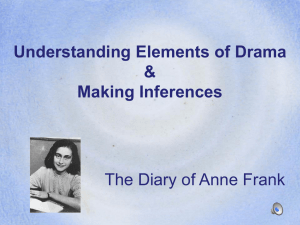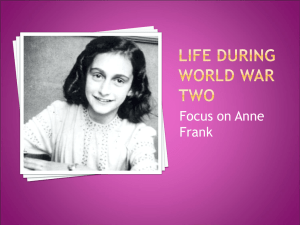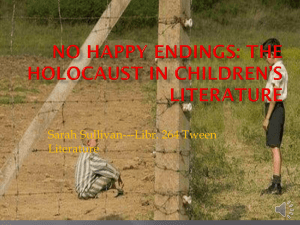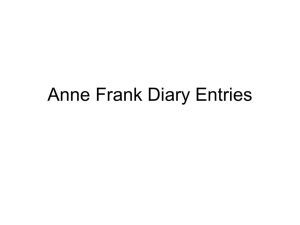the anne frank story and the holocaust in holland
advertisement
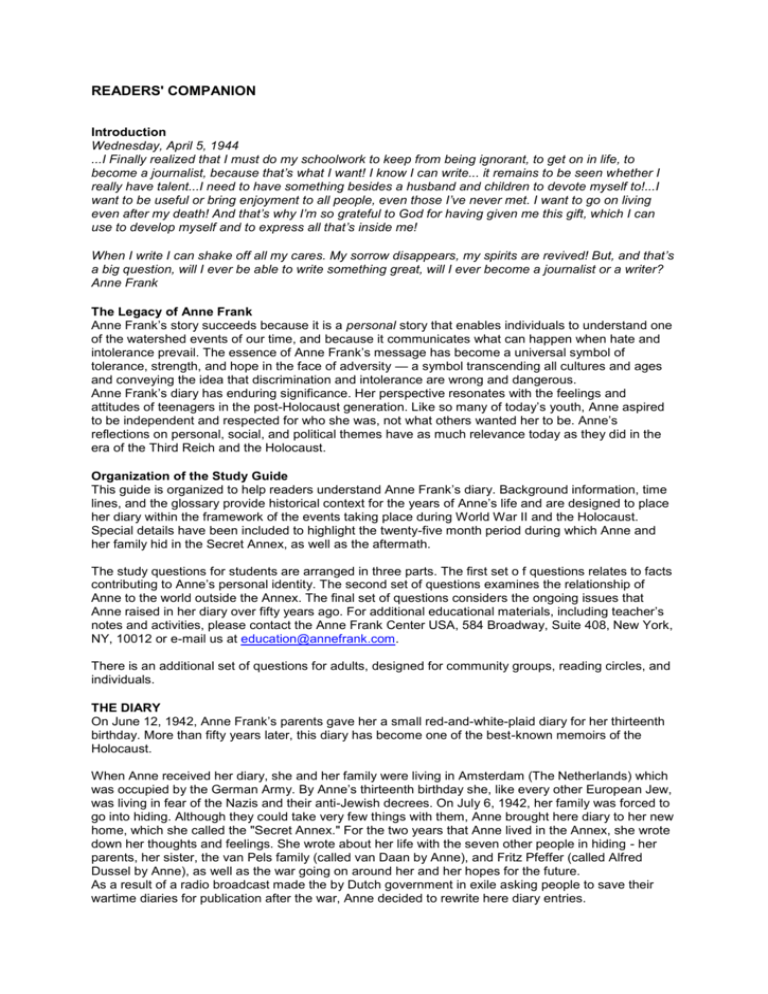
READERS' COMPANION Introduction Wednesday, April 5, 1944 ...I Finally realized that I must do my schoolwork to keep from being ignorant, to get on in life, to become a journalist, because that’s what I want! I know I can write... it remains to be seen whether I really have talent...I need to have something besides a husband and children to devote myself to!...I want to be useful or bring enjoyment to all people, even those I’ve never met. I want to go on living even after my death! And that’s why I’m so grateful to God for having given me this gift, which I can use to develop myself and to express all that’s inside me! When I write I can shake off all my cares. My sorrow disappears, my spirits are revived! But, and that’s a big question, will I ever be able to write something great, will I ever become a journalist or a writer? Anne Frank The Legacy of Anne Frank Anne Frank’s story succeeds because it is a personal story that enables individuals to understand one of the watershed events of our time, and because it communicates what can happen when hate and intolerance prevail. The essence of Anne Frank’s message has become a universal symbol of tolerance, strength, and hope in the face of adversity — a symbol transcending all cultures and ages and conveying the idea that discrimination and intolerance are wrong and dangerous. Anne Frank’s diary has enduring significance. Her perspective resonates with the feelings and attitudes of teenagers in the post-Holocaust generation. Like so many of today’s youth, Anne aspired to be independent and respected for who she was, not what others wanted her to be. Anne’s reflections on personal, social, and political themes have as much relevance today as they did in the era of the Third Reich and the Holocaust. Organization of the Study Guide This guide is organized to help readers understand Anne Frank’s diary. Background information, time lines, and the glossary provide historical context for the years of Anne’s life and are designed to place her diary within the framework of the events taking place during World War II and the Holocaust. Special details have been included to highlight the twenty-five month period during which Anne and her family hid in the Secret Annex, as well as the aftermath. The study questions for students are arranged in three parts. The first set o f questions relates to facts contributing to Anne’s personal identity. The second set of questions examines the relationship of Anne to the world outside the Annex. The final set of questions considers the ongoing issues that Anne raised in her diary over fifty years ago. For additional educational materials, including teacher’s notes and activities, please contact the Anne Frank Center USA, 584 Broadway, Suite 408, New York, NY, 10012 or e-mail us at education@annefrank.com. There is an additional set of questions for adults, designed for community groups, reading circles, and individuals. THE DIARY On June 12, 1942, Anne Frank’s parents gave her a small red-and-white-plaid diary for her thirteenth birthday. More than fifty years later, this diary has become one of the best-known memoirs of the Holocaust. When Anne received her diary, she and her family were living in Amsterdam (The Netherlands) which was occupied by the German Army. By Anne’s thirteenth birthday she, like every other European Jew, was living in fear of the Nazis and their anti-Jewish decrees. On July 6, 1942, her family was forced to go into hiding. Although they could take very few things with them, Anne brought here diary to her new home, which she called the "Secret Annex." For the two years that Anne lived in the Annex, she wrote down her thoughts and feelings. She wrote about her life with the seven other people in hiding - her parents, her sister, the van Pels family (called van Daan by Anne), and Fritz Pfeffer (called Alfred Dussel by Anne), as well as the war going on around her and her hopes for the future. As a result of a radio broadcast made the by Dutch government in exile asking people to save their wartime diaries for publication after the war, Anne decided to rewrite here diary entries. On August 4, 1944, the Nazis raided the Secret Annex and arrested the residents. Anne’s entire diary - including the plaid book, notebooks, and loose sheets of paper - remained behind in the Annex. Tragically, Anne Frank did not survive the Holocaust. Her father, Otto, the sole survivor among those who had hid in the Secret Annex, returned to Amsterdam after the war. Miep Gies, a woman who had risked her life to hide the Franks, gave Otto Anne’s diary, which she had hidden for almost a year. As he read the entries, he was deeply moved by his daughter’s descriptions of life in the Annex and her feelings about her family and the other residents. He decided to publish the diary so that readers would learn about the effects of the Nazi dictatorship and its process of dehumanization. In the immediate aftermath of the war it was not easy for Otto to find a publisher for Anne’s work. He was told that no one wanted to read about the Holocaust. Finally a newspaper called Het Parool printed a story about Anne’s diary that captured the interest of Contact Publishers, a Dutch firm. In June 1947 Contact published 1,500 copies of the first Dutch edition of the diary. Within years the Contact edition was translated into German, French, and English. Today this version is available in 67 languages and 31 million copies have been sold. The first edition omitted almost 30 percent of Anne’s original diary. Otto Frank quite deliberately excluded sections where Anne expressed negative feelings about her mother and others in the Annex, believing that Anne wouldn't have liked such views made public. In addition, Contact was a conservative publishing house and was uncomfortable printing Anne’s entries concerning her burgeoning sexuality. Otto Frank gave the diary to the Netherlands Institute for Was Documentation (Rijksinstituue voor Oorlogsdocumentatie (RIOD), which received it after his death in 1980. Scholars associated with RIOD were particularly interested in refuting the accusations by neo- Nazi Holocaust deniers that the diary was a hoax. To establish its validity, RIOD performed tests on the paper, ink, and glue used in the diary, proving that it was written during the 1940's. Also, tests were performed on Anne’s handwriting, comparing samples from the diary with her other writings, which included letters with dated stamp cancellations. In 1986 RIOD published The Critical Edition of Anne’s diary. This edition is often used as the scholarly, research-oriented version of the diary and contains all of the entries that Otto Frank and the Contact Publishers had removed from the original 1947 edition. Entries that Anne rewrote after March 1944 are placed next to the original entries to show here development as a writer. The 1986 edition also includes transcripts of the tests verifying the authenticity of the diary, as well as some of the short stories and sketches written in the annex. In 1995 Doubleday published The Definitive Edition , on the fiftieth anniversary of Anne Frank’s death. This edition, based on a new English translation of the original Dutch text, contains entries that both Otto Frank and Contact Publishers omitted from the 1947 edition. By restoring sections from the original diary, the 1995 edition makes readers aware of the complexity and sensitivity of Anne Frank, an adolescent struggling to find her own identity during turbulent and uncertain times. THE FRANK FAMILY Anne Frank, born on June 12, 1929, was the second daughter of Otto and Edith Frank, both from respected German Jewish families engaged in commerce for many generations. Otto Frank could trace his heritage in Frankfurt back to the seventeenth century, and Edith Hollander Frank came from a prominent Aachen family. Anne and her older sister, Margot, were raised in Germany in an atmosphere of tolerance; the Franks had friends of many faiths and nationalities. Otto Frank served honorably as an officer in the German Army during World War I. However, the circumstances of the early 1930s dramatically altered the situation for the Frank family. The National Socialist German Workers’ Party, the Nazis, ascended to power in 1933 and launched a campaign to rid Germany of its Jewish citizens. The Nazis blamed the Jews for the economic, political, and social hardships that had befallen Germany, thought less than 1 percent of the German population was Jewish. Many German Jews felt this to be a passing phenomenon, while others, including the Frank family, decided to leave Germany altogether. The Franks decided to move to Amsterdam, the Netherlands, which had been known for centuries as a safe haven for religious minorities. In the summer of 1933 Otto Frank left Frankfurt for Amsterdam to set up a branch of his brother’s company called the Dutch Opekta Company, which produced pectin, an ingredient used in making jam. Edith, with her daughters Margot and Anne, went to Aachen to stay wither her family, the Hollanders, until Otto Frank established the business and found a new home for his family. By the mid-1930s the Franks were settling into a normal routine in their apartment at 37 Merwedeplein: the girls were attending school; the family took vacations at the beach; and their circle of Jewish and non-Jewish friends grew. In 1938 Otto expanded his business, going into partnership with the spice merchant Hermann van Pels, also a Jewish refugee from Nazi Germany. Unfortunately, the Frank’s belief that Amsterdam offered them a safe haven from Nazism was shattered when, in May 1940, Germany invaded the Netherlands and the Franks were once again forced to live under Nazi rule. In the first years of the occupation, Anne and Margot continued to socialize with their friends and attend school. But the Nazi administration, in conjunction with the Dutch Nazi Party and civil service, began issuing anti-Jewish decrees. As Anne wrote on June 20, 1942: Our freedom was severely restricted by a series of anti-Jewish decrees: Jews were required to wear a yellow star; Jews were required to turn in their bicycles; Jews were forbidden to use streetcars; jews were forbidden to ride in cars, even their own; Jews were required to do their shopping between 3 and 5 p.m.; Jews were required to frequent only Jewish-owned barbershops and beauty parlors; Jews were forbidden to be out on the streets between 8 p.m. and 6 a.m.;... Jews were forbidden to visit Christians in their homes; Jews were required to attend Jewish schools, etc. Fortunately, Otto Frank, in anticipation of this decree, had already turned his business over to his nonJewish colleagues Victor Kugler and Johannes Kleiman. By 1942 mass arrests of Jews and mandatory service in German work camps were becoming routine. Fearful for their lives, the Frank family began to prepare to go into hiding. They already had a place in mind - an annex of rooms above Otto Frank’s office at 263 Prinsengracht in Amsterdam. In addition, people on the office staff at the Dutch Opekta Company had agreed to help them. Besides Kugler and Kleiman, there were Miep and Jan Gies, Bep Voskuijl, and Bep’s father - all considered to be trustworthy. These friends and employees not only agreed to keep the business operating in their employer’s absence; they agreed to risk their lives to help the Frank family survive. Mr. Frank also made arrangements for his business partner, Hermann van Pels, along with his wife, Auguste, and their son, Peter, to share the Prinsengracht hideaway. While these preparations were secretly under way, Anne celebrated her thirteenth birthday on June 12, 1942. On July 5, 1942, her sister Margot, received a call-up notice to be deported to a "work camp." Three days later Anne remembered: Margot told me that the call-up was not for Father, but for her. At his second shock, I began to cry. Margot is sixteen - apparently they want to send girls her age away on their own. But thank goodness she won’t be going; Mother had said so herself, which must be what Father had meant when he talked to me about our going into hiding. Hiding...where would we hide? In the city? In the country? In a house? In a shack? When, where, how...? These were questions I wasn’t allowed to ask... Even though the hiding place was not yet ready, the Frank family realized that they had to move right away. They hurriedly packed their belongings and left notes implying that they had left the country. On the evening of July 6, they moved into their hiding place. A week later, on July 13, the van Pels family joined the Franks. On November 16, 1942, the seven residents of the Secret Annex were joined by its eighth and final resident, Fritz Pfeffer. For two years the Franks were part of an extended family in the Annex, sharing a confined space and living under constant dread of detection and arrest by the Nazis and their Dutch sympathizers. Since the Annex was above a business, and buildings on either side were occupied, the eight residents had to be extremely quiet so they wouldn’t be discovered. They also lived in fear of breakins, which became common during the occupation. Their only link to the outside world was through their helpers and radio broadcasts from the BBC. For Anne, the normal stresses of changing from a child to a teenager to a young woman were heightened by the confined space. She recorded all of this in her diary. Part of her entry for Friday, December 24, 1943, reads: Whenever someone comes in from outside, with the wind in their clothes and the cold on their cheeks, I feel like burying my head under the blankets to keep from thinking, "When will we be allowed to breather fresh air again?"...I long to ride a bike, dance, whistle, look at the world, feel young and know that I’m free, and yet I can’t let it show. At approximately 10 a.m., August 1944, the Frank family’s greatest fear was realized. A Nazi policeman and several Dutch collaborators appeared at 263 Prinsengracht, having received an anonymous phone call about Jews hiding there, and charged straight for the bookcase leading to the Secret Annex. Karl Josef Silberbauer, an Austrian Nazi, forced the residents to turn over all valuables. When he found out that Otto Frank had been a lieutenant in the German Army during World War I, he treated the family with a little more respect. The residents were taken from the house, forced onto a covered truck, taken to the Central Office for Jewish Emigration, and then to Weteringschans Prison. Two of the helpers, Victor Kugler and Johannes Kleiman, were also imprisoned, for their role in hiding the prisoners. Miep Gies and Bep Voskuijl were not arrested, although Miep was brought in for questioning by the police. The Nazi and Dutch police left the Secret Annex a mess. They had emptied Otto Frank’s briefcase, which held Anne’s diary, onto the floor to fill it with valuables. The floor was strewn with clothing, paperwork, and other belongings of those who had been hiding there. Miep and Bep returned to the Annex and found Anne’s diary and family photo album in the clutter. Miep brought the diary downstairs, where she kept it hidden in her desk. About a week later the Nazis emptied out the entire Annex. On August 8, 1944, after a brief stay in Weteringschans Prison, the residents of the Secret Annex were moved to Westerbork transit camp. They remained there for nearly a month, until September 3, when they were transported to the Auschwitz death camp in Poland. Ironically, it was the last Auschwitz-bound transport ever to leave Westerbork. Upon arrival at Auschwitz, the men were separated from the women. Hermann van Pels was the first to die. He was murdered in the gas chambers on September 6. Fritz Pfeffer was moved to Neuengamme concentration camp in Germany (probably via Sachsenhausen or Buchenwald), where he died on December 20, 1944. In October 1944 Anne, Margot, and Mrs. Van Pels were transported to the Bergen-Belsen concentration camp in Germany. Edith Frank remained in the women’s subcamp at AuschwitzBirkenau, where she died on January 6, 1945. Thousands died from planned starvation and epidemic at Bergen-Belsen, which was without food, heat, medicine, or elementary sanitary conditions. Anne and Margot, already debilitated, contracted typhus and grew ever sicker. Both Ane, fifteen years old, and Margot, nineteen years old, died in March, 1945. Mrs. Van Pels was transported to Buchenwald and finally to the Theresienstadt camp in Czechoslovakia, where she died in the Spring of 1945. Her son Peter was sent from Auschwitz on a death march. He survived the march but died in Mauthausen in Austria, on May 5, 1945, a few days before the camp was liberated. Otto Frank, the only resident of the annex to survive the Holocaust, returned to Amsterdam after the war. He was totally unaware of the deaths of his daughters. He searched all possible leads to locate them before learning from a woman who had been with the sisters in the barracks at Bergen-Belsen that they had died. Otto also discovered that his wife, the van Pels family, and Fritz Pfeffer had all died in the Holocaust. Fortunately, all of the helpers managed to survive the war. Johannes Kleiman and Victor Kugler had been sent to the Amersfoort police transit camp, and sentenced, without trial, to forced labor. Kleiman fell ill during this time and was sent home; he lived in Amsterdam until his death in 1959. Kugler escaped during an air raid and made his way back to Amsterdam; he emigrated to Canada in 1955 and died there in 1989. Bep Voskuijl died in Amsterdam on May 6, 1983. Miep and Jan Gies remained in Amsterdam, raising a son. Jan died on January 26, 1993. Miep continues to live in Amsterdam, where she is active in educating people about the Holocaust and its lessons for today’s society. Otto Frank found it difficult to settle permanently in Amsterdam with its constant reminders of his lost family. He and his second wife, Elfriede Geiringer, also an Auschwitz survivor, moved to Basel, Switzerland, in 1953, Otto Frank died on August 19, 1980, at the age of ninety-one. RESTORED DIARY ENTRIES Entries with restored material in the Definitive Edition of Anne Frank: The Diary of A Young Girl include: HISTORICAL Sunday, June 14, 1942 Tuesday, February 8, 1944 Monday, June 15, 1942 Tuesday, February 15, 1944 Wednesday, July 1, 1942 Thursday, February 17, 1944 Sunday, July 12, 1942 Sunday, February 20, 1944 Friday, August 21, 1942 Thursday, March 2, 1944 Wednesday, September 2, 1942 Wednesday, March 8, 1944 Thursday, October 1, 1942 Friday, March 10, 1944 Saturday, October 3, 1942 Saturday, March 11, 1944 Wednesday, October 7, 1942 Sunday, March 12, 1944 Wednesday, October 14, 1942 Saturday, March 18, 1944 Monday, November 2, 1942 Friday, March 24, 1944 Thursday, November 5, 1942 Saturday, March 25, 1944 Saturday, May 1, 1943 Thursday, April 27, 1944 Sunday, May 2, 1943 Tuesday, May 9, 1944 Saturday, August 7, 1943 Thursday, May 11, 1944 Tuesday, August 10, 1043 Thursday, May 25, 1944 Thursday, December 30, 1943 Friday, June 2, 1944 Wednesday, January 19, 1944 Tuesday, June 6, 1944 Sunday, January 30, 1944 Friday, June 30, 1944 CONTEXT OF THE DIARY OF ANNE FRANK Anne Frank’s life (1929-45) spanned the most critical years in the history of the Third Reich and the Holocaust. Born in the waning years of the democratic Weimar Republic, Anne Frank was only four years old when Hitler and the Nazi Party ascended to power. The Weimar Republic, established after Germany’s defeat in World War I, had failed to garner widespread support. Unemployment, inflation, labor unrest, and rising violence in the streets were all associated in the popular mind with the inability and inefficiency of the Weimar politicians. Extremist parties, which put forth promises of a better future, gained popularity. The National Socialist German Workers’ (Nazi) Party, founded in 1919, was among those benefitting from the unsettled political and economic times. Its programs promised to restore honor and greatness to Germany. To accomplish these goals, the Nazis advocated a Germany free of Jews and other groups who endangered the destiny of the Third Reich. In 1933 Adolf Hitler, the leader of the Nazi Party, was appointed Chancellor of Germany. As soon as the Nazis were in power, Jews, a very small minority in Germany, were subjected to arbitrary arrests and attacks in the streets. Humiliation of Jews in their synagogues, an economic boycott of Jewish businesses in April 1933, and the firing of Jewish civil servants further demonstrated the hostile environment. Jews who stayed in Germany witnessed a gradual progression of anti-Semitic measures. While there was sporadic terror against Jews in 1933, by 1935 the Nuremberg Laws determined who the Jews were, legalizing their inferiority and their stateless status. Hundreds of pieces of anti-Semitic legislation became law in the middle and late 1930's, segregating Jews from all aspects of German life. In 1938, as the Third Reich expanded to incorporate Austria and parts of Czechoslovakia, the Nazis escalated their campaign against the Jews. A world conference at Evian, France, with representatives from thirty-two nations, failed to offer any help or haven for the Jews of Germany and Austria. On November 9 and 10, 1938, a nationwide pogrom, later known as Kristallnacht (Night of the Broken Glass) resulted in massive destruction of Jewish property and synagogues. Thirty thousand Jewish men and boys were arrested and deported to concentration camps. On the eve of the war Hitler ordered the killing of institutionalized handicapped patients, calling them "useless eaters." The program, named T-4, transferred the victims to six institutions in Germany and Austria, some equipped with special gas chambers. WORLD WAR II The German surprise invasion of Poland in September 1939 began World War II and greatly expanded the Third Reich. Countries in Easter and Western Europe were rapidly invaded. By 1940 Denmark, Norway, Belgium, Luxembourg, and France were controlled by the Nazis, who established ghettos, transit cams, and forced-labor camps, in addition to the concentration camps. The Nazis rounded up and deported massive numbers of prisoners, putting them into hundreds of new camps filled with political opponents, resistance fighters, Jews, Gypsies, homosexuals, Jehovah’s Witnesses, and other victims of the Nazi policies. The German invasion and conquest of the Netherlands began on May 10, 1940, and ended on May 14, after the destruction of Rotterdam. Throughout most of Nazi-occupied Europe the Nazis now expanded their program to make Europe judenrein, or "Jew-free," an idea that had been introduced in the 1930's. However, during the war years anti-Semitic legislation and physical violence against Jews intensified. In the Netherlands, they were registered, isolated, and removed from public life; their businesses were Aryanized within eighteen months. The year 1941 marked a turning point in the course of the war. The German Army invaded the Soviet Union, thereby increasing by 3 million the number of Jews under their domination. Mobile killing squads called Einsatzgruppen followed the German army throughout the conquered territories, where they rounded up people, forced them to undress in front of mass graves, and shot them in masses. In the summer and fall of 1941, the Nazi hierarchy decided to move to the next stage of their policy regarding Jews. This led to the period of systematic mass murder in death camps, beginning in late 1941, which the Nazis referred to in their code words "The Final Solution of the Jewish Question." The six killing sites, close to rail lines in various areas of Poland, were at Belzec, Sobibor, Treblinka, Chelmo, Majdaned, and Auschwitz-Birkenau. The purpose of the death camps was mainly to kill Jews, but there were many other victims as well. Majdanek and Auschwitz-Birkenau were special cases, having both labor facilities and killing centers. Other camps such as Bergen-Belsen became places of death for thousands of victims through starvation and disease. In addition to these camps, the Nazis continued to expand the slave-laborcamp system to thousands throughout the Third Reich. Here prisoners were literally worked until they were no longer useful to the Nazis, then put to death. There were, however, people throughout the Third Reich who found the courage to help others. Like the Franks’ helpers, many risked their lives to hide Jews and others from the Nazis. Organized resistance to the Nazis was punishable by death, but despite this, there were armed revolts by Jews in the death camps of Treblinka, Sobibor, and Auschwitz. The uprising in the Warsaw Ghetto held off German soldiers from April to May 1943. THE HOLOCAUST IN THE NETHERLANDS In the Netherlands the first mass arrests of Jews began in February 1941. The Nazis began Rassen, or roundups: Jewish men and boys were grabbed from their homes, beaten, and deported. In June 1941 the Dutch people of Amsterdam protested in a two-day strike which Nazi troops quickly put down. In the first months that the Frank family lived in the Secret Annex, the death camps in Poland were operating at full capacity. Anne sensed the danger for Jews, although she was not aware of the full magnitude of mass murder occurring hundreds of miles to the east. As she remarked in her diary on November 19, 1942: In the evening when it’s dark, I often see long lines of good, innocent people accompanied by crying children, walking on and on, ordered about by a handful of men who bully and beat them until they nearly drop. No one is spared. The sick, the elderly, children, babies, and pregnant women - all are marched to their death. Listening to the news of the war on the radio was extremely important to the inhabitants of the Annex. Only Germany’ defeat would end the mass killing of Jews and other innocent victims. During 1943 and 1944, reports of Germany’s military reversals provided the Annex residents with hope for the future. News of events such as the halting of German troops in the Soviet Union in February 1943, as well as the Allied invasion of Sicily and Italy beginning the following July, prompted Anne to write optimistically about the approaching end of the war. Nevertheless, she was saddened to realize that the declining military situation for Germany did not mitigate the war against the Jews. She especially despaired over the massive arrests and deportation of Hungarian Jews in May and June 1944. Although D Day operations elated Anne and the others in the Annex, the war still dragged on, leaving them wondering when it would ever end. On July 15, 1944, Anne expressed her sense of foreboding: It’s utterly impossible for me to build my life on a foundation of chaos, suffering and death. I see the world being slowly transformed into a wilderness, I hear the approaching thunder that, one day, will destroy us too. I feel the suffering of millions. And yet, when I look up at the sky, I somehow feel that everything will change for the better, that this cruelty too shall end, that peace and tranquility will return once more. In the meantime, I must hold on to my ideals. Perhaps the day will come when I’ll be able to realize them! THE END OF THE WAR The arrests of the residents of the Secret Annex on August 4, 1944, and their subsequent deportation from Westerbork to Auschwitz took place during the months that the Germans were facing defeat. Soviet troops had already entered the Majdanek death camp in Lublin and publicized the horrors they found. As the Allies reached the occupied countries, the Nazis began to cover up the evidence of genocide and forced prisoners to march on foot toward central Germany to prevent their liberation. Many inmates died or were killed if they could not walk. During the final days, in the spring of 1945, conditions at the remaining camps were so inhumane that many more died. Concentration camps such as Bergen-Belsen became a death trap for thousands, including Anne and Margot Frank. On November 24, 1944, SS leader Heinrich Himmler ordered the destruction of Auschwitz’s crematoria and the removal of as many prisoners as possible as the Russians approached the camp. The loss of Jewish lives in the Netherlands alone illustrates the magnitude of mass murder that occurred during the Holocaust. By July 1944 the country was virtually judenrein. In 1940 approximately 140,000 Jews had lived in the Netherlands during the Nazi occupation; 106,000 Jews there, three out of every four, perished. By May 1945 Nazi Germany collapsed and the war was over in Europe. The SS guards fled the concentration, forced-labor, and death camps. The camps were liberated and the world saw the evidence of the Holocaust. THE AFTERMATH After the war the world tried to grapple with what had happened and to work to prevent its recurrence. As Otto Frank prepared Anne’s diary for publication, the International Military Tribunal at Nuremberg sought to prosecute some of the Nazi leaders and to document their crimes as a warning for the future. Judges from the Allied Powers, including Great Britain, France, the United States, and the Soviet Union, heard evidence against twenty-two Nazi criminals for "crimes against peace" and "war crimes," which violated the laws and customs of warfare, and "crimes against humanity." Fourteen high-ranking Nazis were sentenced to death; others were sent to prison. Most of those prosecuted admitted that they were guilty of the crimes of which they were accused. Their defense? That they were simply following orders of a higher established power. The Nazis’ leader, Adolf Hitler, was not present at the Nuremberg Trials. He and several of his aides had committed suicide in the final days of the war. Subsequent trials have continued to this day. In the United States, where many war criminals escaped, the government deports those who participated in the persecution during the Nazi regime and came to the country illegally. The Nuremberg trials revealed fully what can happen when a state decides to dehumanize its citizens. The hope was to seek justice against those who participated in the murder of millions, including Anne Frank, simply because they were Jewish. STUDY QUESTIONS FOR TEACHERS AND CLASSROOM USE 1. WHO WAS ANNE FRANK? a) About one week after Anne received her diary she wrote in it the saying. "Paper has more patience than people." (June 20, 1942.) Why did Anne think she could confide more in her diary than in people? Almost two years later Anne wrote: "Will I ever be able to write something great, will I ever become a journalist or a writer? I hope so, oh, I hope so very much, because writing allows me to record everything, all my thoughts, ideals and fantasies." (April 5, 1944.) Did Anne’s diary mean something different to her after she had been in hiding? b) On March 7, 1944, Anne wrote a long entry about how she had changed during her life in the Annex: "When I think back to my life in 1942, it all seems so unreal. The Anne Frank who enjoyed that heavenly existence was completely different from the one who has grown wise within these walls...I look back at that Anne Frank as a pleasant, amusing, but superficial girl, who has nothing to with me." In what ways did Anne show that she was becoming a young woman by the age of fourteen? How did Anne envision herself as a grown woman? How was this different from her image of her mother? What did Anne read that influenced her perspective on becoming a woman? Whom did Anne talk to about her new feelings, and why? c) Anne lived in the Annex with her family and four other people for over two years. At times the confinement overwhelmed her: "All the bickering, tears, and nervous tension have become such a stress and strain that I fall into my bed at night crying and thanking my lucky stars that I have half an hour to myself." (October 29, 1943.) How did Anne cope with all of the "stress and strain" of living in the Annex? One of Anne’s struggles focused on a writing table in the room she shared with Mr. Pfeffer. Why was this table so important to Anne? Do you agree with the way Anne handled the disagreement? What would you have done? What do you consider private space? 2. ANNE FRANK IN THE WORLD b) What were the ways the residents of the annex got information about the outside world? How did their sources of information reflect their view of events? Compare Anne’s description of an event during World War II with an "outside" (newspaper, history book) description. b) Anne often worried about her Jewish friends. On November 27, 1943, Anne described her dream about her friend Hanneli Goslar. What do you think this dream was about? Why was the dream so disturbing for Anne? Compare this dream to Anne’s original description of Hanneli (June 15, 1942). Hanneli Goslar was sent to the Bergen-Belsen concentration camp with her family. During the winter of 1944-45 Hanneli and Anne met at the camp, on either side of a fence, three times. The last time Hanneli managed to get a small Red Cross package over the fence to Anne. Hanneli survived the Holocaust and moved to Israel, where she still lives in 1995, often speaking about Anne Frank and the Holocaust. Imagine you are writing a magazine article about Anne Frank’s childhood friends. Construct an interview of Hanneli Goslar. Base the first set of questions on Anne’s diary, and the second set on Hanneli’s life during the Holocaust. What other information would you include in your article? c) The Frank family relied on the support of a number of non-Jewish helpers. These helpers were always in danger of being found out and severely punished. "This morning Mr. van Hoeven was arrested. He was hiding two Jews in his house. It’s a heavy blow for us, not only because those poor Jews are once again balancing on the edge of any abyss, but also because it’s terrible for Mr. van Hoeven...Mr van Hoeven is a great loss for us too. Bep can’t possibly lug such huge amounts of potatoes all the way here." (May 25, 1944.) What did Anne think about the helpers? Did she think that they were heroes? Find Anne’s descriptions of each of the helpers to back up your view. What is your definition of a hero? d) On June 20, 1942, Anne listed many of the restrictions the Nazis placed on Jews during the Third Reich. Make a list, based on the diary, of what Anne could no longer do. How would your day be different if you had to follow these laws? Describe a typical day for you under these restrictions. 3. BEYOND THE DIARY c) When Anne wrote about the growing anti-Semitism in the Netherlands, she said: "Oh, it’s sad, very sad that the old adage has been confirmed for the umpteenth time: ‘What one Christian does is his own responsibility, what one Jew does reflects on all Jews.’" (May 22, 1944) What is a stereotype? Create your own definition. How did stereotypes contribute to the dehumanization process that happened in Anne’s world? Do any of the stereotypes that Anne wrote about still exist? What other stereotypes exist b) Anne was very concerned about the world around her. Afer her fifteenth birthday she wrote: "One of the many questions that have often bothered me is why women have been, and still are thought to be, so inferior to men. It’s easy to say it’s unfair, but that’s not enough for me; I’d really like to know the reason for this great injustice!" Study the attitudes of the early 1940's and today. Why did Anne believe that women were considered inferior? Was Anne a feminist ahead of her time? c) Anne wrote: "I don’t believe the war is simply the work of politicians and capitalists. Oh no, the common man is every bit as guilty; otherwise, people and nations would have rebelled long ago!" (May 3, 1944.) Otto Frank was the only survivor of the Secret Annex. Who was responsible? Was it the leaders? Was it those who enforced the legislation? Was it those who transported them on cattle cars? Was it those who administered the concentration and death camps? Was it the townspeople near the camp? QUESTIONS FOR GROUP DISCUSSIONS (ADULT READERS) a) After the Nazi invasion of the Netherlands in May 1940, the Dutch people were immediately faced with the question of choice: How to respond to the Nazi occupation. Tens of thousands of Dutch people followed Hitler, and millions more looked the other way. Eventually, a resistance movement began to grow. The Nazis needed Dutch collaborators to carry out their fascist decrees. What would have influenced someone to become a collaborator? What factors would have encouraged someone to join the resistance? Do you think these factors were based on personal characteristics or political beliefs? What was the price of resistance during the war? What was the price of collaboration? b) Anne Frank and her family were German refugees who resettled and tried to build their lives in the Netherlands. Although the Franks were proud of their German heritage, their feelings toward Germany became very complicated during the war. Anne wrote: "Fine specimens of humanity, those Germans, and to think I’m actually one of them! No. That’s not true, Hitler took away our nationality long ago. And besides, there are no greater enemies on earth than the Germans and Jews." (October 9, 1942) Although Anne had lived in the Netherlands since 1934, she did not become a Dutch citizen. Did Anne have a nationality? If not, were Ane’s civil rights protected by an nation? By 1939 some 250,000 Jews, half of Germany’s Jewish population, had fled their homeland. Did these refugees have any guaranteed rights? After the war Otto Frank responded to references to "the Germans" by asking "which German?" He believed strongly that blaming all Germans was another form of stereotyping. What constitutes a stereotype? How is a stereotype different from discrimination? c) In The New York Times the writer Anna Quindlen asked, "Would our understanding of the Holocaust be quite the same if Anne Frank had not taken a small plaid diary into hiding with her? What has most shaped your understanding of World War II: personal experience, Anne’s diary, popular films such as Schindler’s List, newsreel footage, academic or historical texts? d) Otto Frank chose to edit out some of the negative comments Anne made about her mother and a number of the other residents of the Secret Annex - comments that have been restored in the new translation by Susan Massotty. He believed that Anne would have wanted him to do so. Do you think he was correct? e) In her diary Anne opined: "...if you’re wondering if it’s harder for the adults here than for the children, the answer is no...Older people have an opinion about everything and are sure of themselves and their actions. It’s twice as hard for us young people to hold on to our opinions at a time when ideals are being shattered..." (July 15, 1944.) When was the last time as an adult that you experienced the "shattering" of an ideal? Is the media a neutral force, or do you think it plays a role in supporting or destroying idealism? f) Are there certain characteristics common among those few individuals who risked their own lives to rescue Jews during World War II? Why do so many of them deny their own heroism? g) A disturbing number of neo-Nazi groups have taken hold in all parts of the world. What social conditions would be necessary for them to grow? What do you believe would be the most likely basis of another world war: pride, nationalism, fear, racism, economic interests, or religious intolerance? h) Nazi leader Adolf Eichmann was asked how he could explain the killing of 6 million Jews. He answered, "One hundred dead are a catastrophe, a million dead are a statistic." Have we become more or less tolerant of murder since he made this observation? i) Anne Frank wrote: "I don’t believe the war is simply the work of politicians and capitalists. Oh no, the common man is every bit as guilty; otherwise, people and nations would have rebelled long ago!" (May 3, 1944.) How should accountability be assigned? So many say they never understood what was happening. How likely could that have been? j) Hitler published Mein Kampf in 1925, describing his plan for the elimination of Jews. At that time, what steps might have been taken to stop Hitler’s rise to power?





